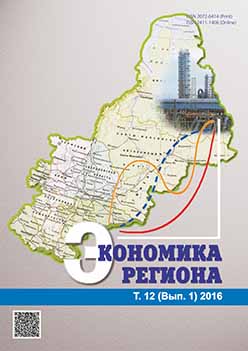Эффективность регионального здравоохранения
Regional Healthcare Effectiveness
Author(s): Olga Vladimirovna Kudelina, Sofya Leonidovna EreminaSubject(s): Economy, Geography, Regional studies
Published by: Институт экономики Уральского отделения Российской академии наук
Keywords: regional healthcare; effectiveness of healthcare; availability of health resources; use of health resources; availability of medical care; medical care; performance indicators; healthcare expenditure;
Summary/Abstract: An evaluation of healthcare systems effectiveness of the regions of the Russian Federation (federal districts) was conductedusing the Minmax method based on the data available at the United Interdepartmental Statistical Information System. Fourgroups of components (i.e. availability of resources; use of resources; access to resources and medical effectiveness) decomposedinto 17 items were analyzed. The resource availability was measured by four indicators, including the provision of doctors,nurses, hospital beds; agencies providing health care to the population. Use of resources was measured by seven indicators:the average hospital stay, days; the average bed occupancy, days; the number of operations per 1 physician surgical; the costper unit volume of medical care: in outpatient clinics, day hospitals, inpatient and emergency care. Access to the resourceswas measured by three indicators: the satisfaction of the population by medical care; the capacity of outpatient clinics; theaverage number of visits to health facility. The medical effectiveness was also measured by three indicators: incidence withthe "first-ever diagnosis of malignancy"; life expectancy at birth, years; the number of days of temporary disability. The studyof the dynamics of the components and indexes for 2008–2012 allows to indicate a multidirectional influence on the regionalhealthcare system. In some federal districts (e.g. North Caucasian), the effectiveness decreases due to resource availability, inothers (South, North Caucasian) — due to the use of resources, in others (Far Eastern, Ural) — due to access to resources. Itis found that the effectiveness of the healthcare systems of the federal districts differs significantly. In addition, the built matrixproves the variability the of effectiveness (comparison of expenditures and results) of healthcare systems of the federal districts ofthe Russian Federation: the high results can be obtained at high costs (the Far Eastern federal district) as well as at low costs (theVolga federal district). There is no possibility of reaching average results under any expenditures level (i.e. neither high, nor low,nor average). The proposed method of evaluation may become a basis for the creation of the strategic development programs ofregional healthcare and the modeling of various scenarios for its realization while reaching the stable balance.
Journal: Экономика региона
- Issue Year: 12/2016
- Issue No: 1
- Page Range: 211-225
- Page Count: 15
- Language: Russian

